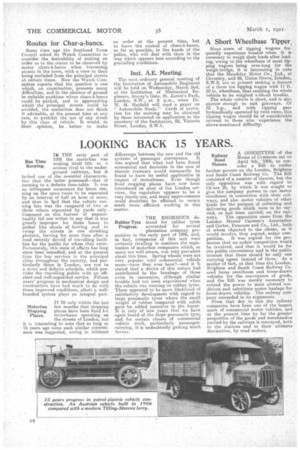LOOKING BACK 15 YEARS.
Page 8

If you've noticed an error in this article please click here to report it so we can fix it.
TT THE early part of 1906 the motorbus was making itself -felt as a serious rival to the underground railways, but it lacked one of the essential characteristics that the latter -possessed—that of . running to a definite time-table. It was no infrequent occurrence for buses running on the same route to be separated by an interval of half an hour or more, and then to find that the vehicle running late was the vanguard of two or three others separated by yards only-Comment on this feature of unpunctuality led one writer to say that it was grossly improper for these buses to gather like shoals of herring and to sweep the streets in one shrieking phalanx, leaving for some time after a road entirely devoid of travelling facilities for the public for whom they cater: Fortunately, this state of affairs has long since been remedied, and at the present time the bus services in the principal cities throughout the country, and particularly those in London, are run to a strict and definite schedule, which provides the travelling public with an efficient and well-organized service. Fifteen years' progress in mechanical design and construction have had much to do with these improved conditions, albeit a well founded system plays an integral part.
Bus Time Keeping.
IT IS 'only within the last Motorbus few months that stopping Stopping places have been fixed for Places. motorbuses operating on the streets of London, but it is interesting to note that so long as 15 years ago some such similar convenience was suggested, owing to inherent differences between the new and the 'old systems of passenger conveyance. It was argued that what had been found economical and desirable in the case of electric tramcars would necessarily be found to have its useful application in respect of motorbuses. Even though fixed stopping places have now . been introduced on most of the London services, the regulation appearsto be a very elastic one, and many improvements could doubtless be effected to secure much more efficient working in this matter.
THE ENORMOUS deRubber Tyre mend for rubber tyres
Progress. accountedfor several
plantation company promotions in the early part of 1906, and, in fact, companies of this sort were seriously rivalling in numbers the registration of motorbus companies which, as many are well aware, was very prevalent about this time. Spring wheels were not very popular with commercial vehicle users—have they ever been ?—and it is stated that a, device of this nature had contributed to the breakage of three axles in succession, although similar trouble had not been experienced when the vehicle was running on rubber tyres. There appeared to be more likelihood of satisfactory development with regard to large pneumatic tyres where the small weight of rubber compared with solids gave n added incentive to the buyer. It is only of late years that we, have again heard of the large pneumatic tyre, and for certain classes of commercial vehicle work, particularly passengers carrying, it is undoubtedly gaining much favour. A COMMITTEE of the House of Commons sat on
Road
April 40,;1906, to con Motors. skier a Bill to confer further powers on the London, Brighton and South Coast Railway Co. The Bill consisted of a number of clauses, but the only opposition was with regard to Ck-use 16, by which it was sought to give the company powers to run motor omnibuses in connection with their railways, and also motor vehicles of other kinds for the purpose of collecting and delivering goods whieh were to be carried, or had been carried; on the railwa)rs. The opposition came from the London Master Carmen 's Association and Carter, Paterson and Co. Ltd., both of whom objected to the efause, as it would involve, they argued, unfair com
petition. It was, argued for the promoters that no unfair competition would be involved, and that it would be for the public convenience and in 'the public interest that there should be only one carrying 'agent instead of three. As a matter _of fact, at that time the London, Brighton and South Coast Railway -Co. used horse omnibuses and horse-drawn vehicles for the conveyance of goods, and the Bill was merely necessary to extend the power. to meet altered conditions and substitute motor haulage for horse-drawn vehicles. The railway company succeeded in its arguments.
From that day 'to this ,the railway companies have been one of the largest users of commercial motor Vehicles, and at the present time by far the 'greater proportion of the goods and merchandise carried by the railways is conveyed, both to the stations and to their ultimate destination, by road motors.
































